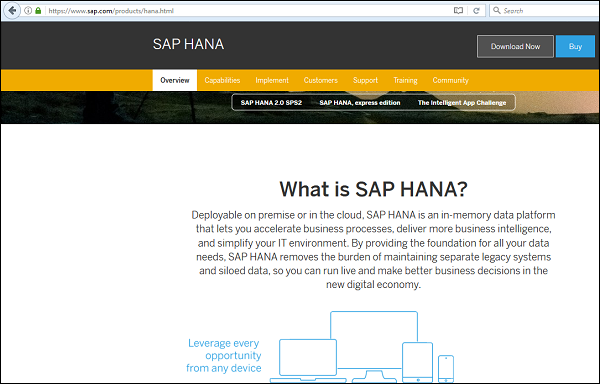
- Home
- Introduction
- Reporting and Dashboard Tools
- Different BO Tools Connection to HANA
- Creating a Relational Connection
- Creating an OLAP Connection
- HANA Modeling Views
- Input Parameters in HANA
- Using Attribute View
- Using Analytic View
- Using Calculation View
- Using Tables in HANA DB
- Connecting Webi to HANA
- Universe Development
- User Prompts and Filter in IDT
- Webi Report Development
- Lumira Connection to HANA
- Dashboard Development in Lumira
- Dashboard Designer Connection to HANA
- Dashboard Development in DD
- Connecting Crystal to HANA Views
- Crystal Report Development on HANA
- BW on HANA Connection
- Design Studio Connection with HANA
- Development in Design Studio
- Publishing BI Reports on HANA
- Benefits of Using HANA
- Connecting HANA with Other BI Tools
- Interview Questions
SAP HANA BI Development - Introduction
SAP HANA is an in-memory database which also provides HANA Modeling, Data Provisioning, and BI reporting features in a single application. SAP HANA is mostly used as a Data Warehouse for many organizations with Transaction system. SAP is providing HANA as a backend database for various different ERP and CRM based applications.
Following are a few common HANA based modules −
- S/4 HANA (S/4 HANA Finance and Logistics)
- SAP Business One
- SAP Fiori
SAP HANA Data Modeling helps the user to model the application data and perform database functions such as creating schemas, tables, and views at run time. HANA data models are stored in HANA Repository and objects are activated at run time.
This is SAP site link for HANA Product details that shares all key features HANA provides − https://www.sap.com/products/data-cloud/hana.html

According to SAP - "Deployable on premise or in the cloud, SAP HANA is an in-memory data platform that lets you accelerate business processes, deliver more business intelligence, and simplify your IT environment. By providing the foundation for all your data needs, SAP HANA removes the burden of maintaining separate legacy systems and siloed data, so you can run live and make better business decisions in the new digital economy."
BI development is always a challenge for organizations with massive amount of historical data. Traditional databases or DW systems - SQL Server, BW or Oracle - doesn't support live reporting, as they are not capable of running the transaction system and Data Warehouse on the same system. In many organizations, transactional system and Data warehouse are kept separate, as running complex OLAP queries affect the performance of the systems significantly. ETL processes are used to perform extraction, transformation, and data load from SAP ECC to Data Warehouse.
When large number of concurrent OLTP transactions are made along with OLAP queries, there is a possibility of the system getting crashed. SAP HANA supports real-time data replication from the transaction system using SLT method, which is a trigger-based approach of data replication.
SAP HANA is an in-memory database, hence the data read is 1 million times faster as compared to traditional systems. Complex OLAP queries in a Business Intelligence report takes less time to run when DW system contains huge amount of historical data. HANA supports all aggregations on fly, and hence, there is no need to save aggregated table in the database. Due to different compression algorithms and column-based storage of table, HANA database requires less space to store more data as compared with other RDBMS systems.